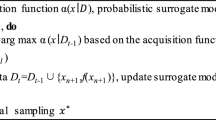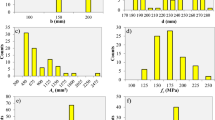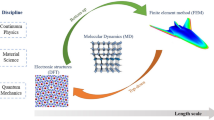Abstract
The capacity efficiency of load carrying with the accurate serviceability performances of reinforced concrete (RC) structure is an important aspect, which is mainly dependent on the values of the ultimate bond strength between the corroded steel reinforcements and the surrounding concrete. Therefore, the precise determination of the ultimate bond strength degradation is of paramount importance for maintaining the safety levels of RC structures affected by corrosion. In this regard, hybrid intelligence and machine learning techniques are proposed to build a new framework to predict the ultimate bond strength in between the corroded steel reinforcements and the surrounding concrete. The proposed computational techniques include the multilayer perceptron (MLP), the radial basis function neural network and the genetic expression programming methods. In addition to that, the Levenberg–Marquardt (LM) deterministic approach and two meta-heuristic optimization approaches, namely the artificial bee colony algorithm and the particle swarm optimization algorithm, are employed in order to guarantee an optimum selection of the hyper-parameters of the proposed techniques. The latter were implemented based on an experimental published database consisted of 218 experimental tests, which cover various factors related to the ultimate bond strength, such as compressive strength of the concrete, concrete cover, the type steel, steel bar diameter, length of the bond and the level of corrosion. Based on their performance evaluation through several statistical assessment tools, the proposed models were shown to predict the ultimate bond strength accurately; outperforming the existing hybrid artificial intelligence models developed based on the same collected database. More precisely, the MLP-LM model was, by far, the best model with a determination coefficient (R2) as high as 0.97 and 0.96 for the training and the overall data, respectively.










Similar content being viewed by others
References
Nepal J, Chen HP, Alani AM (2013) Analytical modelling of bond strength degradation due to reinforcement corrosion. In: Key engineering materials. Trans Tech Publ, pp 1060–1067
Sæther I (2011) Bond deterioration of corroded steel bars in concrete. Struct Infrastruct Eng 7:415–429
Hoang N-D, Chen C-T, Liao K-W (2017) Prediction of chloride diffusion in cement mortar using multi-gene genetic programming and multivariate adaptive regression splines. Measurement 112:141–149
Güneyisi EM, Mermerdaş K, Gültekin A (2016) Evaluation and modeling of ultimate bond strength of corroded reinforcement in reinforced concrete elements. Mater Struct 49:3195–3215
Yalciner H, Eren O, Sensoy S (2012) An experimental study on the bond strength between reinforcement bars and concrete as a function of concrete cover, strength and corrosion level. Cem Concr Res 42:643–655
Yartsev VP, Nikolyukin AN, Pluzhnikova TM (2018) Assessment and modeling of bond strength of corroded reinforcement in concrete structures. Adv Mater Technol
Bilcik J, Holly I (2013) Effect of reinforcement corrosion on bond behaviour. Procedia Eng 65:248–253
Al-Sulaimani GJ, Kaleemullah M, Basunbul IA (1990) Influence of corrosion and cracking on bond behavior and strength of reinforced concrete members. Struct J 87:220–231
Chung L, Kim J-HJ, Yi S-T (2008) Bond strength prediction for reinforced concrete members with highly corroded reinforcing bars. Cem Concr Compos 30:603–611
Coccia S, Imperatore S, Rinaldi Z (2016) Influence of corrosion on the bond strength of steel rebars in concrete. Mater Struct 49:537–551
Güneyisi E, Gesoğlu M, Karaboğa F, Mermerdaş K (2013) Corrosion behavior of reinforcing steel embedded in chloride contaminated concretes with and without metakaolin. Compos Part B Eng 45:1288–1295
Sun H, Burton HV, Huang H (2020) Machine learning applications for building structural design and performance assessment: state-of-the-art review. J Build Eng 1:101816
Arain QA, Memon H, Memon I et al (2017) Intelligent travel information platform based on location base services to predict user travel behavior from user-generated GPS traces. Int J Comput Appl 39:155–168
Memon I (2018) Distance and clustering-based energy-efficient pseudonyms changing strategy over road network. Int J Commun Syst 31:e3704
Concha NC, Oreta AWC (2019) Bond strength prediction model of corroded reinforcement in concrete using neural network. Int J 16:55–61
Zhang J, Wang Y (2020) Evaluating the bond strength of FRP-to-concrete composite joints using metaheuristic-optimized least-squares support vector regression. Neural Comput Appl 1:1–15
Ben Seghier MEA, Carvalho H, Keshtegar B et al (2020) Novel hybridized adaptive neuro-fuzzy inference system models based particle swarm optimization and genetic algorithms for accurate prediction of stress intensity factor. Fatigue Fract Eng Mater Struct 43:2653–2667
Zhou Y, Zheng S, Huang Z et al (2020) Explicit neural network model for predicting FRP-concrete interfacial bond strength based on a large database. Compos Struct 240:111998
Coelho MRF, Sena-Cruz JM, Neves LAC et al (2016) Using data mining algorithms to predict the bond strength of NSM FRP systems in concrete. Constr Build Mater 126:484–495
Mai SH, El M, Ben A, et al (2020) A hybrid model for predicting the axial compression capacity of square concrete-filled steel tubular columns. https://doi.org/10.1007/s00366-020-01104-w
Hoang N-D (2019) Estimating punching shear capacity of steel fibre reinforced concrete slabs using sequential piecewise multiple linear regression and artificial neural network. Measurement 137:58–70
Luo H, Paal SG (2018) Machine learning–based backbone curve model of reinforced concrete columns subjected to cyclic loading reversals. J Comput Civ Eng 32:4018042
Dahou Z, Sbartaï ZM, Castel A, Ghomari F (2009) Artificial neural network model for steel–concrete bond prediction. Eng Struct 31:1724–1733
Golafshani EM, Rahai A, Sebt MH, Akbarpour H (2012) Prediction of bond strength of spliced steel bars in concrete using artificial neural network and fuzzy logic. Constr Build Mater 36:411–418
Hoang N-D, Tran X-L, Nguyen H (2020) Predicting ultimate bond strength of corroded reinforcement and surrounding concrete using a metaheuristic optimized least squares support vector regression model. Neural Comput Appl 32:7289–7309
Nait M, Abdelfetah M, Ouaer H et al (2020) Modeling viscosity of CO 2 at high temperature and pressure conditions. J Natural Gas Sci Eng 77:1
Haddad R, Haddad M (2020) Predicting fiber-reinforced polymer–concrete bond strength using artificial neural networks: a comparative analysis study. Struct Concr
Köroğlu MA (2019) Artificial neural network for predicting the flexural bond strength of FRP bars in concrete. Sci Eng Compos Mater 26:12–29
Ouaer H, Hosseini AH, Amar MN, et al (2020) Rigorous connectionist models to predict carbon dioxide solubility in various ionic liquids
Asteris PG, Kolovos KG (2019) Self-compacting concrete strength prediction using surrogate models. Neural Comput Appl 31:409–424
Naderpour H, Rafiean AH, Fakharian P (2018) Compressive strength prediction of environmentally friendly concrete using artificial neural networks. J Build Eng 16:213–219
Golafshani EM, Behnood A (2018) Application of soft computing methods for predicting the elastic modulus of recycled aggregate concrete. J Clean Prod 176:1163–1176
Zhao X, Wang S, Ma J et al (2019) Identification of driver’s braking intention based on a hybrid model of GHMM and GGAP-RBFNN. Neural Comput Appl 31:161–174
Ahmed AN, Noor CWM, Allawi MF, El-Shafie A (2018) RBF-NN-based model for prediction of weld bead geometry in Shielded Metal Arc Welding (SMAW). Neural Comput Appl 29:889–899
Elzwayie A, El-Shafie A, Yaseen ZM et al (2017) RBFNN-based model for heavy metal prediction for different climatic and pollution conditions. Neural Comput Appl 28:1991–2003
Chen S, Cowan CFN, Grant PM (1991) Orthogonal least squares learning algorithm for radial basis function networks. IEEE Trans Neural Netw 2:302–309
Ferreira C (2001) Gene expression programming: a new adaptive algorithm for solving problems. pp 1–22
Murad Y, Ashteyat A, Hunaifat R (2019) Predictive model to the bond strength of FRP-to-concrete under direct pullout using Gene expression programming. J Civ Eng Manag 25:773–784
Koza JR, Koza JR (1992) Genetic programming: on the programming of computers by means of natural selection. MIT Press, Cambridge
Severcan MH (2012) Prediction of splitting tensile strength from the compressive strength of concrete using GEP. Neural Comput Appl 21:1937–1945
Teodorescu L, Sherwood D (2008) High energy physics event selection with gene expression programming. Comput Phys Commun 178:409–419
Amar MN, Ghriga MA, El M, et al (2020) Prediction of lattice constant of A 2 XY 6 cubic crystals using gene expression programming
Kennedy J, Eberhart R (1995) PSO optimization. In: Proceedings of the IEEE international conference on neural networks. pp 1941–1948
Clerc M (1999) The swarm and the queen: towards a deterministic and adaptive particle swarm optimization. In: Proceedings of the congress on evolutionary computation, CEC 99. pp 1951–1957
Panigrahi BK, Shi Y, Lim M-H (2011) Handbook of swarm intelligence: concepts, principles and applications. Springer, Berlin
Chatterjee S, Sarkar S, Hore S et al (2017) Particle swarm optimization trained neural network for structural failure prediction of multistoried RC buildings. Neural Comput Appl 28:2005–2016
Karaboga D (2005) An idea based on honey bee swarm for numerical optimization. Technical report-tr06, Erciyes university, engineering faculty, computer
Fun M-H, Hagan MT (1996) Levenberg-Marquardt training for modular networks. In: Proceedings of International Conference on Neural Networks (ICNN’96). IEEE, pp 468–473
Keshtegara B, Seghier M, el Ben A (2018) Modified response surface method basis harmony search to predict the burst pressure of corroded pipelines. Eng Fail Anal 89:177–199. https://doi.org/10.1016/j.engfailanal.2018.02.016
El M, Ben A, Keshtegar B et al (2020) Prediction of maximum pitting corrosion depth in oil and gas pipelines. Eng Fail Anal 112:104505
Author information
Authors and Affiliations
Corresponding author
Ethics declarations
Conflict of interest
The authors of the manuscript confirm that there are no conflicts of interest regarding its publication.
Additional information
Publisher's Note
Springer Nature remains neutral with regard to jurisdictional claims in published maps and institutional affiliations.
Rights and permissions
About this article
Cite this article
Ben Seghier, M.E.A., Ouaer, H., Ghriga, M.A. et al. Hybrid soft computational approaches for modeling the maximum ultimate bond strength between the corroded steel reinforcement and surrounding concrete. Neural Comput & Applic 33, 6905–6920 (2021). https://doi.org/10.1007/s00521-020-05466-6
Received:
Accepted:
Published:
Issue Date:
DOI: https://doi.org/10.1007/s00521-020-05466-6




